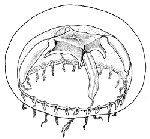WoRMS taxon details
Teclaiidae Bouillon et al., 2000
marine, fresh, terrestrial
Bouillon, J.; Pagès, F.; Gili, J. M.; Palanques, A.; Puig, P. & Heussner, S. (2000). Deep-water Hydromedusae from the Lacaze-Duthiers submarine canyon (Banyuls, northwestern Mediterranean) and description of two new genera, <i>Guillea</i> and <i>Parateclaia</i>. <em>Scientia Marina.</em> 64(S1)., available online at https://doi.org/10.3989/scimar.2000.64s187
page(s): 91 [details] Available for editors [request]
[request]
page(s): 91 [details] Available for editors
Schuchert, P. (2024). World Hydrozoa Database. Teclaiidae Bouillon et al., 2000. Accessed through: World Register of Marine Species at: https://www.marinespecies.org/aphia.php?p=taxdetails&id=231786 on 2024-04-18
Date
action
by
![]() The webpage text is licensed under a Creative Commons Attribution 4.0 License
The webpage text is licensed under a Creative Commons Attribution 4.0 License
original description
Bouillon, J.; Pagès, F.; Gili, J. M.; Palanques, A.; Puig, P. & Heussner, S. (2000). Deep-water Hydromedusae from the Lacaze-Duthiers submarine canyon (Banyuls, northwestern Mediterranean) and description of two new genera, <i>Guillea</i> and <i>Parateclaia</i>. <em>Scientia Marina.</em> 64(S1)., available online at https://doi.org/10.3989/scimar.2000.64s187
page(s): 91 [details] Available for editors [request]
[request]
additional source Bouillon, J.; Gravili, C.; Pagès, F.; Gili, J.-M.; Boero, F. (2006). An introduction to Hydrozoa. Mémoires du Muséum national d'Histoire naturelle, 194. Muséum national d'Histoire naturelle: Paris, France. ISBN 2-85653-580-1. 591 + 1 cd-rom pp. (look up in IMIS) [details]
page(s): 91 [details] Available for editors
additional source Bouillon, J.; Gravili, C.; Pagès, F.; Gili, J.-M.; Boero, F. (2006). An introduction to Hydrozoa. Mémoires du Muséum national d'Histoire naturelle, 194. Muséum national d'Histoire naturelle: Paris, France. ISBN 2-85653-580-1. 591 + 1 cd-rom pp. (look up in IMIS) [details]
From editor or global species database
Diagnosis Hydroid phase is not known. Medusa with four simple radial canals, tentacles hollow, manubrium with four simple lips; elongated, sac-like gonads on radial canals, separated from manubrium; one to three cordyliform structures between successive tentacles; with or without open statocysts. [details]
